Sony DT 35 mm f/1.8 SAM
3. Build quality
The dimensions of the DT 1.8/35 you can assess looking at the picture below where it is positioned between the Sony 1.4/50 and the a-mount version of the Sony Alpha Sigma 1.4/30 without an HSM motor.
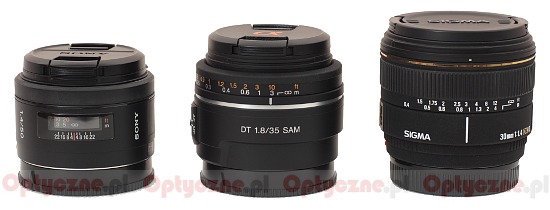 |
Please Support UsIf you enjoy our reviews and articles, and you want us to continue our work please, support our website by donating through PayPal. The funds are going to be used for paying our editorial team, renting servers, and equipping our testing studio; only that way we will be able to continue providing you interesting content for free. |
- - - - - - - - - - - - - - - - - - - - - - - - - - - - - - - - - - - - - - - - - - - - - - - -
As you see, the 1.8/35 model, although designed for small sensors is not exactly small or dainty. After all it is even slightly bigger than the faster Sony 1.4/50, designed for full frame, and just a bit smaller than the Sigma which is faster and provides a big wider angle of view.
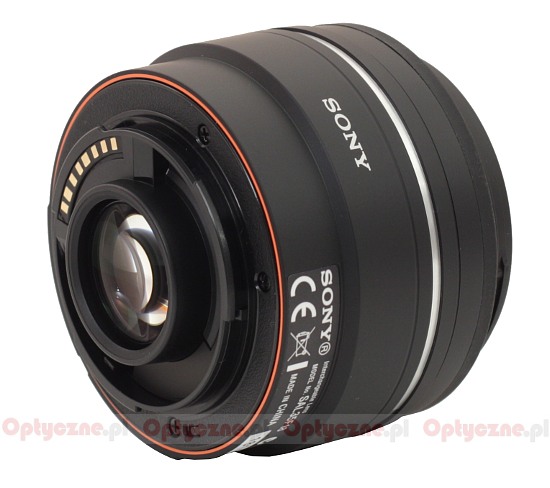 |
The lens, which was made in China, starts with a plastic mount where you can find contacts and a rear element, 24 mm in diameter. The element is situated more or less on the same level as the mount when the lens is set at infinity. When you pass to the minimum focus the element hides over 1 cm inside the barrel. By the way if you move the focus ring not only this element but also the whole optical system is shifted so the lens keeps its focal length.
The lens’s barrel is made of smooth black plastics which doesn’t appear to be exceptionally solid. The overall assessment of solidity is as bad here as, let’s say, in the case of the Canon EF 50 mm f/1.8 II.
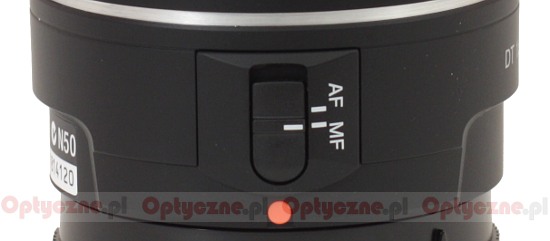 |
Right behind the mount, on the left side of the barrel, we can find a focus mechanism mode switch (AF/MF). Even further on we see a silver stripe behind which there is a manual focus ring. It is 1 cm wide and is not ribbed, with a distance scale, expressed in meters and feet. Here the Sony is closer to the better build Nikkor 1.8/35 than to the Canon 1.8/50 which didn’t even feature any distance scale. The Sony’s ring is a bit loose and it moves with audible whirr. Running through the whole scale takes a turn through about 100 degrees.
The turn of the ring while passing to the minimum focus make the system of elements extend outside the barrel by about 1 cm. That movement doesn’t cause any rotation of the filter thread, though, which here is 55 mm in diameter. The front element of the lens is almost 3 cm in diameter.
When it comes to the optical construction the lens consists of 6 elements positioned in 5 groups. The Sony is a relatively simple device. Only the Pentax 2.4/35 has the same number of elements, remaining significantly slower for a change. Inside the tested lens there is an aperture with seven diaphragm blades which can be closed down to f/22.
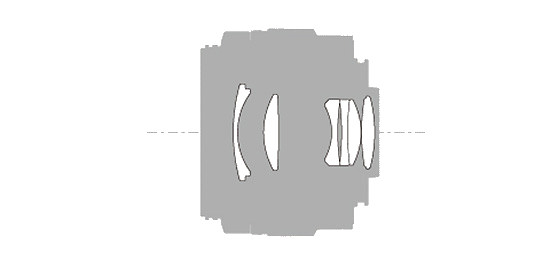
The buyer gets two caps and a hood included in the box.
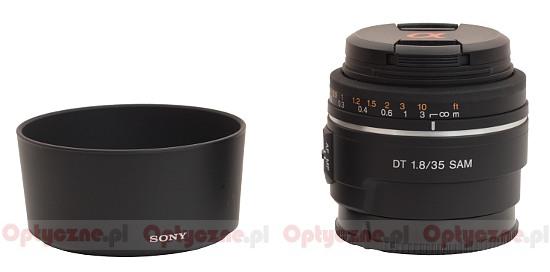 |






